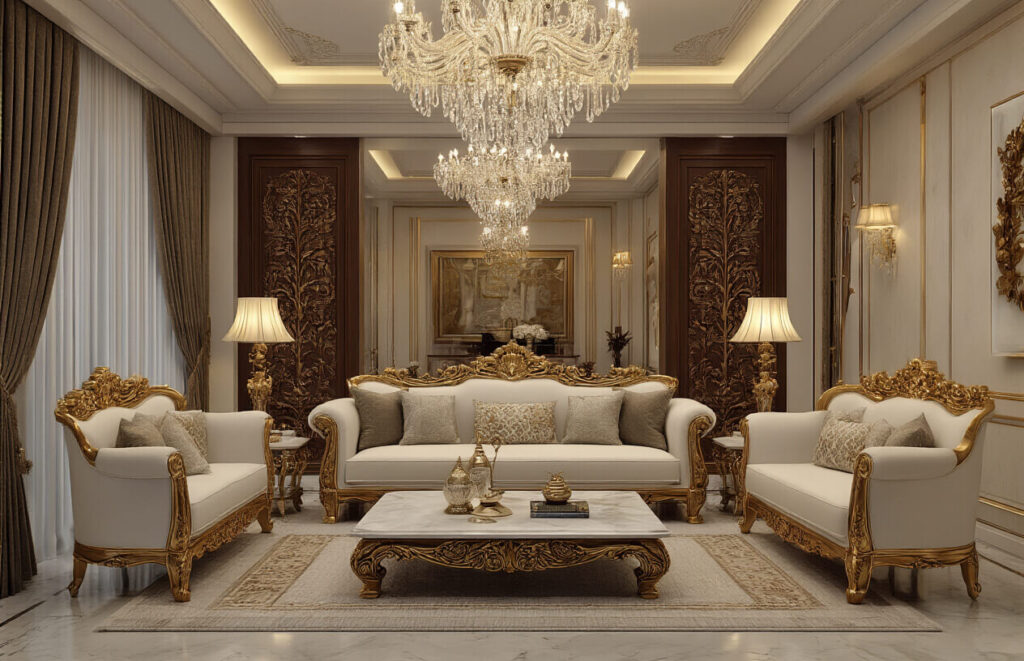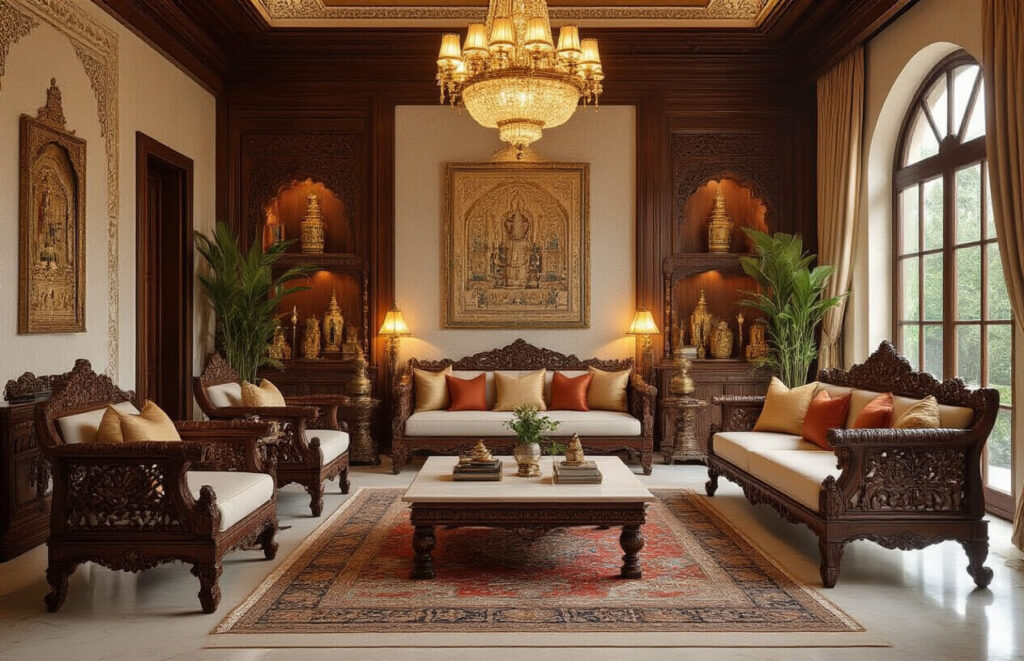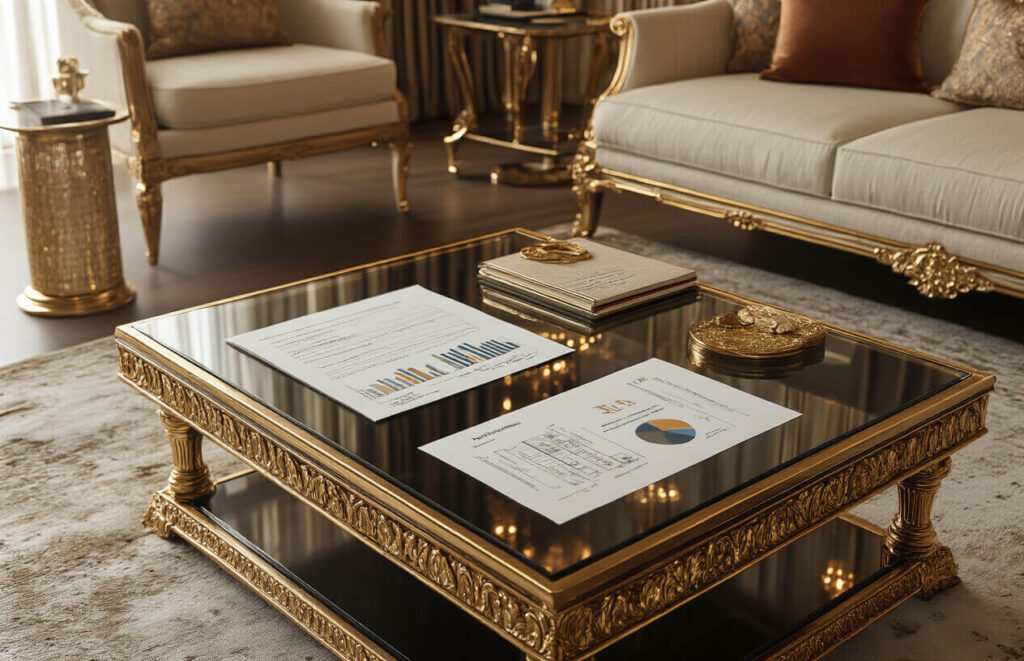
Picture this: You just dropped a fortune on your dream home, but it still feels like you’re living in a fancy luxury hotel room. Sound familiar?
Every year, India’s elite spend millions on properties that never quite feel like “home.” That’s where luxury interior designers in India step in – turning cold spaces into bespoke sanctuaries that scream “you” in every detail.
What separates an ordinary designer from the exceptional ones who craft spaces for Bollywood royalty and tech moguls? It’s not just about expensive furnishings and imported marble.
The real magic happens when your space tells your story – when guests walk in and instantly understand who you are without you saying a word.
But here’s what nobody’s telling you about hiring these design virtuosos…
The Evolution of Luxury Interior Design in India

Traditional Royal Influences in Modern Design
The palaces of Rajasthan and mansions of Gujarat didn’t just disappear into history books. They’re alive and kicking in today’s luxury Indian homes.
Walk into a high-end apartment in Mumbai or a sprawling farmhouse in Delhi, and you’ll spot the unmistakable grandeur of India’s royal past. Carved wooden doors that once adorned havelis now serve as statement pieces in penthouses. Intricate Jaali work, originally designed for ventilation and privacy in palaces, now divides living spaces with artistic flair.
But here’s the thing – today’s designers aren’t just copying and pasting. They’re reimagining. Those heavy, ornate motifs that covered every inch of royal chambers? They’re now used with restraint – perhaps on a single feature wall or incorporated into custom furniture.
Gold and silver inlay work that was everywhere in royal courts now shows up in subtle accent pieces. Think coffee tables with thikri mirror work or consoles with delicate silver detailing.
The colour palette has evolved too. The bold blues of Jodhpur and rich reds of Jaipur haven’t disappeared, but they’ve been reinterpreted through contemporary eyes.
Western Aesthetics Merged with Indian Sensibilities
The magic happens at the intersection. Where Milan meets Mysore. Where Scandinavian minimalism shakes hands with Indian maximalism.
Top Indian designers are creating spaces that could be featured in any global design magazine but still feel undeniably Indian. It’s not about throwing a Buddha statue into an otherwise Western interior and calling it fusion. It’s deeper than that.
Take materials, for instance. Italian marble floors might be paired with hand-carved sandstone wall panels. Sleek European kitchen systems get customized with Indian brass hardware.
The furniture tells the same story. Clean-lined sofas upholstered in luxurious fabrics sit alongside reimagined traditional pieces like the modern interpretation of a diwan or a contemporary spin on the classic Jhoola (swing). What’s truly exciting is how Indian textiles have found new expression. Banarasi silk isn’t just for sarees anymore – it’s upholstering accent chairs. Phulkari embroidery isn’t confined to Punjab; it’s adorning cushions in Manhattan-style lofts in Gurgaon.
Current Trends Defining Indian Luxury Interiors
Sustainability isn’t just a buzzword in Indian luxury design – it’s the new standard. Forgotten crafts are being revived, not out of nostalgia but because they make environmental sense.
The luxury client in India today wants spaces that tell their personal story. Cookie-cutter opulence is out; thoughtful, curated interiors are in.
Art plays a central role now more than ever. Major Indian artists aren’t just exhibited in galleries; their works are integral to home design. Spaces are conceived with specific art pieces in mind, rather than art being an afterthought.
Technology integration is happening with unprecedented sophistication. Smart homes in India aren’t just about convenience; they’re about creating immersive experiences. Lighting systems that mimic the changing hues of Indian skies throughout the day. Climate control that adjusts based on the harsh seasonal shifts.
Scale is being played with in fascinating ways. Double-height living areas reminiscent of durbar halls. Intimate reading nooks inspired by traditional jharokhas. The juxtaposition creates rhythm and hierarchy within spaces.
Local materials are enjoying a renaissance. Red oxide flooring, once considered old-fashioned, is being reimagined in contemporary contexts. Terrazzo, with its zero-waste appeal, is making a strong comeback in luxury bathrooms and kitchens.
Top Luxury Interior Designers Transforming Indian Homes

Award-Winning Studios and Their Signature Styles
India’s design scene is on fire right now. The country’s top luxury interior designers aren’t just creating beautiful spaces—they’re redefining what Indian luxury means.
Take Gauri Khan Designs. When you walk into one of their spaces, you know it immediately. The bold statement pieces, the perfect blend of contemporary and traditional elements—it’s a signature that’s earned them multiple design excellence awards. Khan’s work for Bollywood celebrities has become legendary, with her fearless use of metallic accents and custom art installations.
Then there’s the ABD Studio by Alyvia Battiwalla. These folks cleaned up at the 2023 India Design Awards with their “less is luxe” philosophy. They’re masters at incorporating heritage pieces into sleek, modern spaces without making it feel like a museum. Their Mumbai penthouse project with that stunning hand-carved wooden ceiling floating above minimalist furniture? Pure genius.
Celebrity-Favoured Designers and Their Projects
The rich and famous aren’t trusting their multimillion-dollar homes to just anyone. They want the best.
Sussanne Khan has become the go-to designer for Bollywood’s elite. Her recent redesign of Hrithik Roshan’s sea-facing apartment blends Mediterranean influences with industrial chic elements—a combination that shouldn’t work but absolutely does in her hands. Her signature? Spaces that look incredible on Instagram but still feel liveable.
Twinkle Khanna’s The White Window has captured a celebrity following with spaces that tell a story. Her design for filmmaker Karan Johar’s mountain retreat uses local craftsmanship in surprisingly contemporary ways. The hand-loomed textiles and repurposed antiques create spaces that feel both fresh and timeless.
Boutique Design Firms Making Their Mark
Big names aren’t the only game in town. Smaller studios are creating some of India’s most innovative luxury spaces.
We’re All Made of Stars, founded by Disha Bhavsar and Shivani Ajmera, is turning heads with their “emotional luxury” approach. Their Mumbai residential project featuring traditional Pichwai art alongside sleek Italian furniture proves luxury doesn’t have to mean imported everything.
Case Design, though small in team size, delivers massive impact. Their celebrated Avasara Academy project showed how luxury can be sustainable and rooted in local context. Their thoughtful use of Rajasthani stone craftsmanship has wealthy homeowners lining up for their distinctively Indian yet globally relevant aesthetic.
International Designers Working in the Indian Market
Global design heavyweights are increasingly drawn to India’s luxury market, bringing fresh perspectives.
Kelly Hoppen’s collaboration with Lodha Group brought her signature neutral palette and East-meets-West aesthetic to Mumbai’s most exclusive addresses. Her disciplined approach to luxury—where every item must earn its place—resonates with India’s new generation of luxury homeowners.
YOO Studio, founded by Philippe Starck and John Hitchcox, made waves with their Hyde Park project in Pune. They’ve mastered the art of blending dramatic, conversation-starting design moments with spaces that honor Indian traditions of family gathering and entertaining.
Distinctive Elements of Indian Luxury Interior Design

Integration of Heritage Craftsmanship
Indian luxury interior design isn’t just about opulence—it’s about telling stories through spaces. Heritage craftsmanship sits at the heart of this narrative, with techniques passed down through generations finding new expression in contemporary luxury homes.
Look at any high-end Indian residence and you’ll spot it: the intricate Jaali work reimagined as room dividers, the traditional thikri mirror mosaics adorning accent walls, or the ancient Pichwai art style transformed into stunning ceiling installations.
What makes Indian luxury unique is how these master craftsmen—woodcarvers from Saharanpur, marble inlay artists from Agra, metal workers from Moradabad—bring centuries-old techniques into modern contexts. These aren’t just decorative elements; they’re living connections to India’s artistic legacy.
Top designers aren’t just incorporating these crafts—they’re collaborating directly with artisan communities, creating exclusive pieces that can’t be replicated by mass production. This partnership elevates both the craftsperson’s status and the home’s distinctive character.
Premium Material Selection and Sourcing
The material palette in Indian luxury interiors reads like a geography lesson of the subcontinent’s finest resources. Designers aren’t settling for the obvious choices anymore.
Instead of generic marble, they’re selecting rare varieties from Makrana quarries. Rather than standard hardwoods, they’re opting for sustainable teak from Kerala or reclaimed timber from heritage structures. Silk doesn’t just come from anywhere—it’s hand-loomed Banaras or Kanchipuram fabric with provenance stories.
Sourcing has become an art form itself. Designers are establishing direct relationships with suppliers across the country, cutting out middlemen to access materials with authenticated origins and superior quality. This direct sourcing enables customization at the raw material level—marble cut specifically for a project or metals alloyed to exact specifications.
The investment in premium materials pays dividends in longevity. These aren’t disposable design elements but heritage pieces designed to appreciate over time.
Technological Innovations in Luxury Spaces
Indian luxury isn’t stuck in the past. The marriage between traditional aesthetics and cutting-edge technology creates spaces that feel both timeless and forward-thinking.
Smart home integration has moved beyond novelty to necessity in high-end projects. But what distinguishes Indian luxury is how seamlessly this technology disappears into the design. Touch panels disguised within carved wooden panels. Climate systems hidden behind jali screens. Lighting arrangements that mimic natural rhythms while highlighting architectural details.
Many luxury designers are now partnering with tech specialists from the planning stages, incorporating systems that anticipate homeowners’ needs rather than just responding to commands. The focus isn’t on showing off technology but on creating experiences enhanced by invisible innovations.
Sustainable Luxury: The New Design Paradigm
Sustainability isn’t just a checkbox for Indian luxury designers—it’s becoming central to their creative approach.
The new luxury client wants spaces that reflect consciousness alongside opulence. This has led to innovative approaches: passive cooling systems inspired by ancient haveli architecture, solar integration that doesn’t compromise aesthetic integrity, and water recycling systems that maintain lush indoor gardens.
Materials with lower environmental impact are gaining prominence. Designers are turning to rapidly renewable resources like bamboo, but elevating them through master craftsmanship into luxury statements. Recycled materials undergo transformations so complete that their origins become part of their appeal rather than a compromise.
Customization and Personalization Approaches
Cookie-cutter luxury is an oxymoron in Indian design circles. True luxury means spaces that couldn’t possibly belong to anyone else.
This goes beyond monograms and family crests. Leading designers start with immersive client experiences—spending time understanding not just preferences but patterns of living, cultural backgrounds, and even travel histories. These insights translate into spaces that feel like physical manifestations of their owners’ identities.
Customization extends to commissioning exclusive art pieces, creating bespoke furniture that fits specific physical proportions, and developing custom material finishes that might appear nowhere else in the world.
The most sophisticated designers are creating spaces that can evolve with their owners—modular elements that can be reconfigured, lighting that can transform moods, and technology that learns and adapts to changing preferences over time.
Regional Influences on Luxury Design Across India

Mumbai’s Contemporary Opulence
Walk into any luxury home in Mumbai and you’ll notice something immediately—space is treated like the ultimate luxury. In a city where real estate comes at a premium, Mumbai’s elite designers transform compact areas into breathtaking displays of contemporary opulence.
Mumbai’s luxury aesthetic blends international influences with distinctly Indian sensibilities. Think sleek Italian furniture paired with handcrafted Indian textiles. These homes often feature floor-to-ceiling windows overlooking the Arabian Sea, bringing that coveted indoor-outdoor living experience to high-rise apartments.
The financial capital’s designers aren’t afraid to go bold with metallics. Gold, brass, and copper accents are everywhere—from statement lighting fixtures to intricate Jali-inspired room dividers. These aren’t your grandmother’s gold accents; they’re reimagined for the 21st century Mumbai power player.
Art plays a central role too. Collectors showcase contemporary Indian artists alongside international pieces, creating homes that double as personal galleries. The walls tell stories of global travels while staying rooted in Indian artistic traditions.
Delhi’s Palatial Grandeur
Delhi’s luxury homes scream heritage. The city’s designers draw heavy inspiration from Mughal architecture and the colonial-era buildings that define the capital. High ceilings, ornate mouldings, and sweeping staircases create that unmistakable sense of Delhi grandeur.
Unlike Mumbai’s space constraints, Delhi’s sprawling farmhouses and bungalows allow designers to think big—really big. Massive chandeliers, oversized furniture, and palatial dining rooms designed for entertaining political and business elites are standard features.
The colour palette here leans traditional—deep reds, royal blues, and emerald greens dominate, often paired with heavy dark wood furniture. Hand-knotted Persian carpets aren’t just floor coverings; they’re family heirlooms and status symbols.
Delhi designers excel at mixing antiques with modern pieces. You’ll spot centuries-old carved wooden doors repurposed as coffee tables sitting comfortably beside custom-designed contemporary sofas. It’s this tension between old and new that gives Delhi interiors their distinctive character.
Bangalore’s Tech-Forward Luxury
Bangalore’s luxury homes reflect the city’s position as India’s tech hub. Smart homes aren’t just a trend here—they’re the standard. Everything from lighting to security to climate control is integrated and controllable via smartphone.
The Garden City’s pleasant climate shapes its luxury designs. Indoor gardens and living walls bring nature inside, while large courtyards serve as the heart of many luxury homes. The boundaries between indoor and outdoor spaces blur deliberately.
Colour schemes tend toward the understated—whites, greys, and earth tones dominate, punctuated by occasional pops of vibrant colour. The overall aesthetic is clean, uncluttered, and highly functional, reflecting the tech industry’s influence on the city’s sensibilities.
Sustainability features prominently in Bangalore’s luxury homes. Solar panels, rainwater harvesting systems, and energy-efficient designs aren’t just environmentally conscious choices—they’re status symbols for the city’s eco-aware elite.
Investment Considerations for Luxury Interior Design

Understanding Pricing Structures
Ever wondered why some interior designers charge you an arm and a leg while others seem surprisingly affordable? The pricing mystery in luxury interior design isn’t actually that mysterious once you break it down.
Most high-end designers in India work with one of these structures:
- Flat Fee: A single price for the entire project
- Percentage-Based: Typically 10-30% of your total project cost
- Hourly Rates: Anywhere from ₹5,000 to ₹20,000 per hour for top-tier designers
- Cost-Plus: The designer purchases items at wholesale and marks them up (usually 20-35%)
The truth? Many luxury designers combine these approaches. You might pay a retainer fee upfront, then hourly charges for design work, plus markups on furnishings.
What really drives costs up isn’t the designer’s time—it’s the custom elements. That hand-carved marble bathtub from Italy? The silk wallpaper hand-painted by artisans? These aren’t just expensive because they’re fancy—they’re expensive because they’re one-of-a-kind.
Cost vs. Value in High-End Design
Dropping ₹50 lakhs on interior design seems insane until you consider what you’re actually buying.
Think of luxury interiors like fine art that you literally live inside. The difference between premium and standard options isn’t just about looking better—it’s about lasting longer and performing better.
Here’s a quick reality check:
| Standard Interior | Luxury Interior |
| Looks good for 5-7 years | Remains timeless for 15+ years |
| Generic materials and finishes | Custom, unique elements |
| Mass-produced furniture | Bespoke pieces with heritage value |
| Functional lighting | Artistic lighting that transforms spaces |
| Follows trends | Sets trends |
The hidden value? Luxury design usually increases property values significantly. Apartments and homes with designer interiors in Mumbai, Delhi and Bangalore often sell for 15-30% more than comparable properties.
Timeline Expectations for Luxury Projects
Patience is more than a virtue in luxury design—it’s a requirement.
High-end interior projects in India typically take:
- Apartments: 6-12 months
- Villas/Bungalows: 12-24 months
- Heritage properties: 18-36 months
Why so long? Because true luxury can’t be rushed. That custom furniture piece is being made by artisans who’ve been perfecting their craft for generations. Those marble slabs are being hand-selected from quarries and matched precisely for your space.
And honestly? The delays are usually worth it. The most common client regret isn’t waiting too long—it’s rushing the process and compromising on quality.
Maintaining and Updating Luxury Interiors
The dirty secret about luxury interiors? They need love—regular, consistent, sometimes expensive love.
Those silk wall coverings? They need specialized cleaning. That imported wood flooring? It requires specific humidity levels and periodic refinishing.
Many top designers in India now include maintenance plans with their projects, scheduling regular check-ins and refurbishments. The smartest clients budget 1-2% of the original project cost annually for maintenance.
For updates, think evolution, not revolution. The best luxury interiors are designed to adapt. Swap art collections, update soft furnishings, or integrate new technology without demolishing the foundational design.

Crafting Opulent Spaces: India’s Luxury Interior Design Landscape
India’s luxury interior design scene has undergone remarkable transformation, blending traditional craftsmanship with contemporary aesthetics. From the pioneering designers revolutionizing Indian homes to the distinctive elements that define luxury in the Indian context, we’ve explored how regional influences from Kerala to Kashmir shape exclusive interior spaces. The thoughtful investment in luxury design creates not just beautiful homes but valuable assets that appreciate over time.
As you embark on your own luxury interior design journey, consider partnering with designers who understand both India’s rich design heritage and global luxury standards. The right designer will translate your vision into a timeless space that honour’s cultural context while delivering uncompromising elegance and comfort. Your luxury interior is more than a statement—it’s a sanctuary that reflects your personal narrative within India’s evolving design story.
Leave a Reply